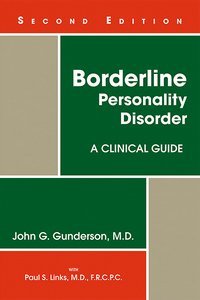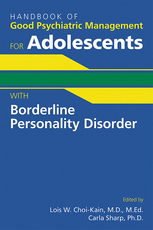Borderline Personality Disorder, Second Edition
A Clinical Guide
View Pricing
Description
Covering the range of clinical presentations, treatments, and levels of care, Borderline Personality Disorder: A Clinical Guide, Second Edition, provides a comprehensive guide to the diagnosis and treatment of borderline personality disorder (BPD). The second edition includes new research about BPD's relationship to other disorders and up-to-date descriptions of empirically validated treatments, including cognitive-behavioral and psychodynamic approaches. Compelling new research also indicates a much better prognosis for BPD than previously known.
A pioneer in the field, author John Gunderson, M.D., director of the Borderline Personality Disorder Center at McLean Hospital, draws from nearly 40 years of research and clinical experience. The guide begins with a clear and specific definition of BPD, informed by a nuanced overview of the historical evolution of the diagnosis and a thoughtful discussion of misdiagnosis. Offering a complete evaluation of treatment approaches, Dr. Gunderson provides an authoritative overview of the treatment options and describes in-depth each modality of treatment, including pharmacotherapy, family therapy, individual and group therapy, and cognitive-behavioral therapies.
Unlike other works, this book guides clinicians in using multiple modalities, including the sequence of treatments and the types of changes that can be expected from each mode. The discussion of each treatment emphasizes empirically validated therapies, helping clinicians choose modalities that work best for specific patients. In addition, Borderline Personality Disorder: A Clinical Guide, Second Edition, also outlines therapeutic approaches for multiple settings, such as hospitalization, partial hospitalization or day hospital programs, and levels of outpatient care.
Complementing the well-organized treatment guide are a series of informative and intriguing sidebars, providing insight into the subjective experience of BPD, addressing myths about therapeutic alliances in BPD, and questioning the efficacy of contracting for safety. Throughout the book, Dr. Gunderson recommends specific do's and don'ts for disclosing the diagnosis, discussing medications, meeting with families, starting psychotherapy, and managing suicidality.
A synthesis of theory and practical examples, Borderline Personality Disorder: A Clinical Guide, Second Edition, provides a thorough and practical manual for any clinician working with BPD patients.
Contents
- About the Authors
- Introduction
- Chapter 1. The borderline diagnosis
- Chapter 2. Differential diagnosis: Overlaps, subtleties, and treatment implications
- Chapter 3. Overview of treatment
- Chapter 4. Case Management: The primary clinician
- Chapter 5. Levels of care: Indications, structure, staffing
- Chapter 6. Pharmacotherapy: Clinical practices
- Chapter 7. Pharmacotherapy: Selection of medications
- Chapter 8. Family interventions and therapies
- Chapter 9. Group therapy
- Chapter 10. Individual psychotherapies: Getting started
- Chapter 11. Cognitive-behavioral therapies: Dialectical behavior therapy and cognitive therapies
- Chapter 12. Psychodynamic psychotherapies
- Chapter 13. Future considerations
- Appendix: Psychoeducational resources
- Index
About the Authors
John G. Gunderson, M.D., is Professor of Psychiatry at Harvard Medical School in Boston, Massachusetts; Director of Psychosocial and Personality Research and Director of the Borderline Personality Disorder Center at McLean Hospital in Belmont, Massachusetts.
Paul S. Links, M.D., F.R.C.P.C., is Professor of Psychiatry at the University of Toronto, Toronto, Canada.
Related Products
Carousel Control - items will scroll by tabbing through them, otherwise arrows can be used to scroll one item at a time








